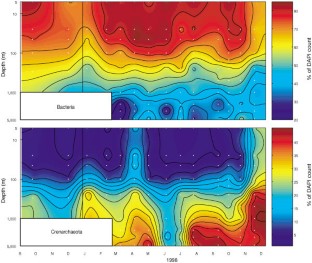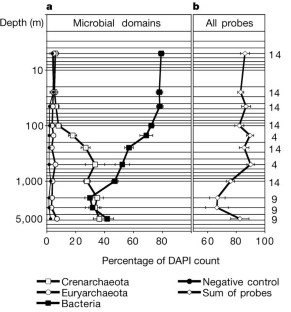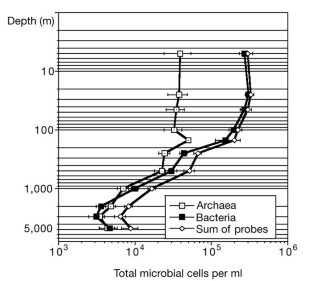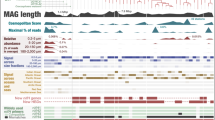Abstract
The ocean's interior is Earth's largest biome. Recently, cultivation-independent ribosomal RNA gene surveys have indicated a potential importance for archaea1in the subsurface ocean2,3,4.But quantitative data on the abundance of specific microbial groups in the deep sea are lacking5,6.Here we report a year-long study of the abundance of two specific archaeal groups (pelagic euryarchaeota and pelagic crenarchaeota)2in one of the ocean's largest habitats. Monthly sampling was conducted throughout the water column (surface to 4,750 m) at the Hawai'i Ocean Time-series station7.Below the euphotic zone (> 150 m), pelagic crenarchaeota comprised a large fraction of total marine picoplankton, equivalent in cell numbers to bacteria at depths greater than 1,000 m. The fraction of crenarchaeota increased with depth, reaching 39% of total DNA-containing picoplankton detected. The average sum of archaea plus bacteria detected by rRNA-targeted fluorescent probes ranged from 63 to 90% of total cell numbers at all depths throughout our survey. The high proportion of cells containing significant amounts of rRNA suggests that most pelagic deep-sea microorganisms are metabolically active. Furthermore, our results suggest that the global oceans harbour approximately 1.3 × 1028archaeal cells, and 3.1 × 1028bacterial cells. Our data suggest that pelagic crenarchaeota represent one of the ocean's single most abundant cell types.
This is a preview of subscription content,access via your institution
Access options
Subscribe to this journal
Receive 51 print issues and online access
185,98 € per year
only 3,65 € per issue
Buy this article
- Purchase on SpringerLink
- Instant access to full article PDF
Prices may be subject to local taxes which are calculated during checkout



Similar content being viewed by others
References
Woese, C. R., Kandler, O. & Wheelis, M. L. Towards a natural system of organisms: Proposal for the domains Archaea, Bacteria, and Eucarya.Proc. Natl Acad. Sci. USA87,4576–4579 ( 1990).
DeLong, E. F. Archaea in coastal marine environments.Proc. Natl Acad. Sci. USA89,5685–5689 ( 1992).
Fuhrman, J. A., McCallum, K. & Davis, A. A. Novel major archaebacterial group from marine plankton.Nature356,148–149 (1992).
Fuhrman, J. A. & Davis, A. A. Widespread Archaea and novel Bacteria from the deep sea as shown by 16S rRNA gene sequences.Mar. Ecol. Prog. Ser.150,275–285 (1997).
Fuhrman, J. A. & Ouverney, C. C. Marine microbial diversity studies via 16S rRNA sequences: cloning results from coastal waters and counting of native archaea with fluorescent single probes.Aquat. Ecol.32,3–15 (1998).
DeLong, E. F., Taylor, L. T., Marsh, T. L. & Preston, C. M. Visualization and enumeration of marine planktonicArchaeaandBacteriaby using polyribonucleotide probes and fluorescentin situhybridization.Appl. Environ. Microbiol.65,5554–5563 (1999).
Karl, D. M. & Lukas, R. The Hawaii Ocean Time-series (HOT) program: Background, rationale and field implementation.Deep-Sea Res.43,129–156 ( 1996).
Porter, K. & Feig, Y. S. The use of DAPI for identifying and counting aquatic microflora.Limnol. Oceanogr.25,943–948 (1980).
Hicks, R. E., Amann, R. I. & Stahl, D. A. Dual staining of natural bacterioplankton with 4′, 6-diamidino-2-phenylindole and fluorescent oligonucleotide probes targeting kingdom-level 16S rRNA sequences.Appl. Environ. Microbiol.58,2158–2163 (1992).
Massana, R., Murray, A. E., Preston, C. M. & DeLong, E. F. Vertical distribution and phylogenetic characterization of marine planktonicArchaeain the Santa Barbara Channel.Appl. Environ. Microbiol.63,50–56 ( 1997).
Murray, A. E.et al.A time series assessment of planktonic archaeal variability in the Santa Barbara Channel.Aquat. Microb. Ecol.20,129–145 (1999).
Olsen, G. J. Archaea, archaea everywhere.Nature371,657–658 (1994).
Stein, J. L. & Simon, M. I. Archaeal ubiquity.Proc. Natl Acad. Sci. USA93,6228– 6230 (1996).
DeLong, E., Wu, K. Y., Prézlin, B. B. & Jovine, R. V. M. High abundance of Archaea in Antarctic marine picoplankton.Nature371,695–697 ( 1994).
Massana, R.et al.Vertical distribution and temporal variation of marine planktonic Archaea in the Gerlache strait, Antarctica, during early spring.Limnol. Oceanogr.43,607–617 (1998).
Amann, R. I., Krumholz, L. & Stahl, D. A. Fluorescent-oligonucleotide probing of whole cells for determinative, phylogenetic, and environmental studies in microbiology.J. Bacteriol.172,762– 770 (1990).
Lee, S. & Kemp, P. F. Single-cell RNA content of natural marine planktonic bacteria measured by hybridization with multiple 16S rRNA-targeted fluorescent probes.Limnol. Oceanogr.39,869–879 (1994).
Murray, A. E.et al.Seasonal and spatial variability of bacterial and archaeal assemblages in the coastal waters near Anvers island, Antarctica.Appl. Environ. Microbiol.64,2585– 2595 (1998).
Glöckner, F. O., Fuchs, B. M. & Amann, R. Bacterioplankton compositions of lakes and oceans: a first comparison based on fluorescencein situhybridization.Appl. Environ. Microbiol.65,3721– 3726 (1999).
Simon, M., Glöckner, F. O. & Amann, R. Different community structure and temperature optima of heterotrophic picoplankton in various regions of the Southern Ocean.Aquat. Microb. Ecol.18,275–284 (1999).
Nagata, T., Fukuda, H., Fukuda, R. & Koike, I. Bacterioplankton distribution and production in deep Pacific waters: Large-scale geographic variations and possible coupling with sinking particle fluxes.Limnol. Oceanogr.45,426–435 (2000).
Courties, C.et al.Smallest eukaryotic organism.Nature370,255 (1994).
Zweifel, U. L. & Hagström, Å. Total counts of marine bacteria include a large fraction of non-nucleoid-containing bacteria (ghosts).Appl. Environ. Microbiol.61,2180–2185 (1995).
Karner, M. & Fuhrman, J. Determination of active marine bacterioplankton: a comparison of universal 16S rRNA probes, autoradiography, and nucleoid staining.Appl. Environ. Microbiol.63,1208– 1213 (1997).
Williams, P. M., Carlucci, A. F. & Olson, R. A deep profile of some biologically important properties in the central North Pacific gyre.Oceanol. Acta3,471–476 (1980).
Menard, H. W. & Smith, S. M. Hypsometry of ocean basin provinces.J. Geophys. Res.71,4305– 4325 (1966).
Acknowledgements
We thank the crew of theRV Moana Wave,L. Tupas and K. Björkman for help with sampling. T. Taylor helped standardizing probing protocols, and L. Fujieki provided computational support. This study was supported by NOAA-Seagrant Office (MBK/DMK), NSF (DMK), and support from the David and Lucile Packard Foundation (EFD). This is SOEST contribution number 5313 and US JGOFS contribution number 647.
Author information
Authors and Affiliations
Corresponding author
Supplementary information
Rights and permissions
About this article
Cite this article
Karner, M., DeLong, E. & Karl, D. Archaeal dominance in the mesopelagic zone of the Pacific Ocean. Nature409,507–510 (2001). https://doi.org/10.1038/35054051
Received:
Accepted:
Issue Date:
DOI:https://doi.org/10.1038/35054051
This article is cited by
-
A unique prokaryotic vertical distribution in the groundwaters of deep sedimentary geological settings in Hokkaido, Japan
Progress in Earth and Planetary Science(2024)
-
Vertical distribution and phylogenetic characterization of marine Archaea in the western subarctic Pacific
Marine Development(2024)
-
Increased prokaryotic diversity in the Red Sea deep scattering layer
Environmental Microbiome(2023)
-
Picoplankton diversity in an oligotrophic and high salinity environment in the central Adriatic Sea
Scientific Reports(2023)
-
Metagenome-based metabolic modelling predicts unique microbial interactions in deep-sea hydrothermal plume microbiomes
ISME Communications(2023)
Comments
By submitting a comment you agree to abide by ourTermsandCommunity Guidelines.If you find something abusive or that does not comply with our terms or guidelines please flag it as inappropriate.



